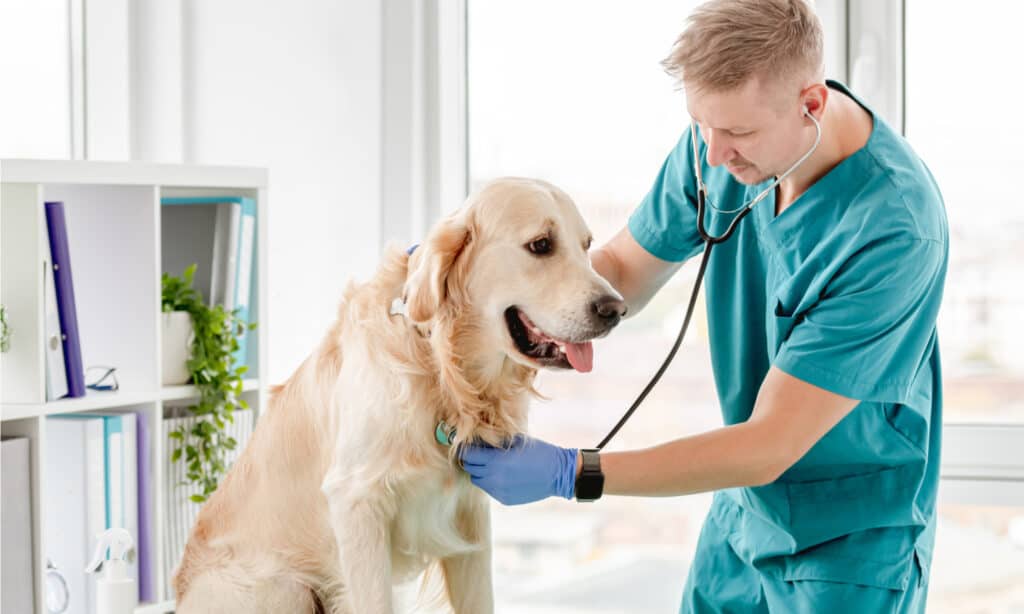If you’re wondering “Why do dogs have seizures?” you’re in the right place. Just like humans and other animals, dogs can have seizures. When there’s strange activity happening suddenly in the brain, a seizure can occur.
Seizures can be a one-time event or they can happen in clusters, taking place multiple times within a 24-hour timeframe. You’ve likely heard of a grand mal seizure. During this type of seizure, the entire body convulses and it can be quite frightening to witness as a dog parent.
The best thing you can do is be educated about the signs, risks, causes, and prevention tactics you can put into place to help your four-legged friend. Below you’ll find everything you need to know.
What Causes Seizures in Dogs
Your dog’s body loses control due to defective electrical activity in its brain. Seizures in dogs can be caused by a variety of factors, including:
- Head injuries
- Diabetes
- Epilepsy
- Heartworms
- Low blood sugar levels
- Ingested poisons such as seeds or chocolate
- Liver disease
- Heat exhaustion
- Tumors
- Nutritional imbalances such as iron deficiency
It’s essential to pay attention to any health-related issues to know whether or not a seizure is possible. Please talk with your vet if you have any concerns.

Golden retrievers are one breed that’s susceptible to seizures
©Tatyana Vyc/Shutterstock.com
Symptoms of Seizures in Canines
Every dog’s seizure might seem a bit different, particularly if it’s a localized seizure. Before a seizure, a dog might:
- Run in circles
- Twitch
- Drool
- Suddenly falling to the floor
- Have stiff muscles
- Stare into space
- Become restless or clingy
- Throw up
- Snap their jaw
- Bark loudly
- Be unable to look at you or anything else.
- Go completely unconscious/pass out.
- Uncontrollably urinating or defecating.
- Bite
- Stare blankly ahead while standing
Dog Breeds With Increased Risk of Seizures
While not every dog of these breeds will have a seizure at some point in their lives, certain breeds are more vulnerable to seizures than others:
- German and Australian Shepherds, Labrador and Golden Retrievers, as well as other large herding and retrieving dogs, are susceptible to seizures. Seizures are prevalent in herding dogs with the MDR1 gene. In addition to the breeds listed above, this can also include longhaired whippets, Shetland Sheepdogs, and Old English Sheepdogs.
- Chasing their tails, extreme fear, and spontaneous aggressiveness can all be symptoms of a hereditary type of epilepsy in Bull Terriers.
- Pugs, Boston Terriers, and English Bulldogs, for example, have small, flat noses and are more susceptible to seizures.

Dogs with the MDR1 gene, including some herding breeds like Old English Sheepdogs, commonly experience seizures.
©Eric Isselee/Shutterstock.com
What Type Of Seizures Do Dogs Have?
The generalized seizure, often known as a grand mal seizure, is the most widespread type. A dog’s awareness can be lost and convulsions can occur. Throughout the brain, uncontrolled electrical activity occurs. Seizures that are generalized last anywhere from a couple of seconds to several minutes.
A focal seizure occurs when irregular electrical activity occurs in only a portion of the brain. Strange gestures in one leg or side of the body might result from focal seizures.
A psychomotor seizure is characterized by abnormal activity that lasts only a few minutes.
Your dog may start fighting an imagined item or chasing its tail out of nowhere. It might be difficult to distinguish psychomotor seizures from unusual behavior, but a dog that suffers from them will consistently act in the same manner when they have a seizure.
Idiopathic epilepsy refers to seizures that have no recognized explanation. They mainly affect dogs between the ages of six months and six years. Idiopathic epilepsy is more prevalent in breeds such as Border Collies, Labs, Beagles, German Shepherds, and more.
What Happens During a Typical Seizure?
There are three main phases of a seizure. As a dog parent, being hyper-aware of these phases can allow you to be more vigilant when a seizure does occur.
Pre-Ictal Phase
The pre-ictal phase is characterized by a period of changed behavior in which the pup may hide, look apprehensive, or seek out its owner. It might be agitated, jittery, whimpering, trembling or drooling. This might last anywhere from a few seconds to several hours. This interval occurs before the seizure movement, as though the dog is anticipating something.
Ictal Phase
The ictal phase can continue anywhere from a couple of seconds to several minutes, and the appearance of the ictal phase can change. The ictal phase can range from minor alterations in mental cognition, such as a confused appearance, moderate shivering, aimless gazing, or licking lips, to a full loss of consciousness and physical function.
When a dog has a grand mal seizure or a full-fledged seizure with unconsciousness, all of the muscles in his body uncontrollably and irregularly move. The dog generally collapses on its side and flaps its legs, appearing to be paralyzed elsewhere.
The head is frequently drawn backward. Incontinence, feces, and drooling are all possible outcomes. The dog is considered to be in status epilepticus, or protracted seizure if the episode does not stop within five minutes.
Post-Ictal
Anxiety, confusion, drooling, pacing, agitation, and even brief blindness can occur during the post-ictal phase, or the time shortly following the termination of the seizure. The length of the post-ictal period has no direct relationship with the severity of the seizure.
What You Can Do if Your Dog Is Having a Seizure
It’s a natural human response to become frightened if you see your dog having a seizure. Your furry friend is part of your family and you care about them deeply. We’ve found the best tips for what you can do as a dog parent in the event that man’s best friend begins seizing.
Remain Calm
We know this is easier said than done, so don’t beat yourself up if you freak out a little. It just means that you care about your pet. If this is the first time your pup has had a seizure or you’ve witnessed one previously, try to remain calm before attending to your dog. If you get in his face and start sobbing or shouting at him, he’ll become even more terrified since dogs are often aware during seizures.

It’s important to keep your dog calm during a seizure.
©iStock.com/Monoliza21
Stay Close
Sit close to your dog, but avoid touching him. Please remember, though, that dogs may bite impulsively during seizures. Likewise, when your dog wakes up, he may be bewildered and attack you out of panic, pain, or bewilderment.
Keep Track of Time
Time your dog’s seizures if you can. Even if you don’t have a stopwatch, keeping an eye on the clock might help you figure out how long the seizing is happening. If the seizure is less than two minutes long, you have nothing to worry about.
Anything between two and five minutes should result in a trip to the emergency vet. Any seizure that lasts longer than five minutes should be treated by a veterinarian immediately. If your dog experiences numerous seizures in a short period of time and does not wake up between them, he should visit a veterinarian as soon as possible.
Move Your Dog
If Fido has a seizure near the stairwell or the edge of the bed, gently move him to a safer spot or lay something soft in front of him to keep him from falling. The time before and after a seizure, canines may become scared and run about without understanding or noticing where they’re going. They may also be unable to control their actions at times, resulting in a seizure that causes them to fall or run into something.
Talk to Them
Speak to your dog in quiet, soothing tones. After a seizure, some owners try playing calm, soothing music for their pets. This is acceptable as long as you don’t play something too loudly. Nevertheless, your pooch could enjoy it more if you simply let him return to normal without any disturbances.
Keep Your Dog Cool
When your dog has a seizure, his body temperature swiftly rises. As a result, gently placing cold hand towels over his paws after the seizure has stopped might be beneficial. Wait till your dog has calmed down before doing this, if you don’t, he may bite you.
Allow Normal Activities
Your dog may be exhausted once he is attentive and awake again. Allow him to sleep. You may want to check on him from time to time, but it’s better if you leave Rover alone. Following a seizure, a dog may become excessively hungry or thirsty. Allow him to eat and drink if he appears attentive and is capable of standing on his feet without swaying or appearing bewildered.
Call the Vet
No matter if this is the first seizure your pup has had or if he has epilepsy, it’s essential to keep your veterinarian in the know. A trip to the vet is a must if the seizure was longer than two minutes. If it’s after hours, call your local emergency vet and schedule a same-day appointment.
How to Prevent Seizures in Dogs
Prevention is the key to a lot in life. Thankfully, there are things you can do to ensure your pooch is happy and healthy. Below you’ll find several helpful tips to keep seizures at bay.
Look at Your Dog’s Genetics
Genetics is essential. When adopting a puppy, inquire about the parents’ seizure history. German shepherds, Siberian huskies, Golden retrievers, Cocker spaniels, and Poodles are among the breeds that are more prone to seizures. Mixed breeds are also affected.
Pay Attention to Overall Health
It’s essential for your dog to eat well. As a pet parent, you want to be aware of how much and what type of food your dog is being fed. Contact your veterinarian about your dog’s individual requirements.
Because liver disease can trigger seizures, you’ll want to check to see that it isn’t present in Fido’s bloodstream. This is more challenging if you buy pups from pet retailers, but if you have a purebred pooch, the breeder should know. Seizures can be caused by low blood sugar as well. As directed by your veterinarian, add carbs and sugars to your dog’s food.
Get Them Tested
During the next vet appointment, have them check your pooch for brain tumors that could cause seizures. Meningiomas, which are frequent in elderly dogs, can be removed during surgery to help with seizures. X-rays will not identify them, but CT scans can detect them early.
It is critical to do lab tests as well. Some dogs have only one seizure and then they never have another. Many dogs, on the other hand, have more than one. When a seizure occurs, the risk of brain injury increases, thus early diagnosis and observation are critical.
The photo featured at the top of this post is © Beach Creatives/Shutterstock.com
Ready to discover the top 10 cutest dog breeds in the entire world?
How about the fastest dogs, the largest dogs and those that are -- quite frankly -- just the kindest dogs on the planet? Each day, AZ Animals sends out lists just like this to our thousands of email subscribers. And the best part? It's FREE. Join today by entering your email below.
Thank you for reading! Have some feedback for us? Contact the AZ Animals editorial team.







